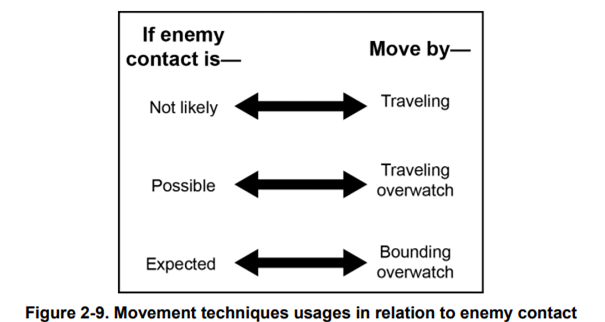TACTICS: Back to Basics
- Robert Parry
- Aug 8, 2023
- 3 min read
Updated: Aug 13, 2023
Before we get into the details on the five forms of maneuver, it’s probably good to brush over the basics of tactical formations. For maneuver Soldiers, this will be a refresher on early OSUT or commissioning program tactics. For others it will be a quick look at some basics. Keep in mind, these principles apply across echelons. Though ranges and sizes scale, these tactics apply to squad-size elements up to brigades. These movement formations and movement techniques are the building blocks of the forms of maneuver.
As always, italics added for our emphasis, and […] indicates we cut out stuff we thought was fluff. And, as always: you’re smarter reading the reg yourself to be exactly sure
The major takeaways:
A movement formation is an ordered arrangement of forces for a specific purpose and describes the general configuration of a unit on the ground.
Movement formations allow a unit to move on the battlefield based on the terrain and enemy threat.
These are the movement formations:
Column.
Line.
Wedge.
Echelon (left or right).
Vee.
Diamond.
Box.
By designating the movement formation planned for use, units—
Establish the geographic relationship between units.
Indicate probable reactions once an enemy force makes contact with the formation.
Indicate the level of security desired.
Establish the preponderant orientation of subordinate weapon systems.
Posture friendly forces for the attack
The use of standard formations allows units to transition from one formation to another, giving additional flexibility when adjusting to changes in the mission variables. In other words, there is a standard and everyone can change on the fly if everyone knows the standard.
Units use the movement formations in conjunction with three movement techniques.Those techniques are:
Traveling
traveling overwatch
bounding overwatch.
Movement techniques limit the unit’s exposure to enemy fire and position the unit to react to enemy contact.
Units select the appropriate movement technique based on the chance of enemy contact.
Each movement formation has its advantages and disadvantages.
A unit may employ a series of movement formations during a movement or maneuver based on changing terrain or threat.
Diving deep in the doctrinal details:
Here are some key sections of doctrine underlying the movement formations and movement techniques:
MOVEMENT FORMATIONS
2-1. A movement formation is an ordered arrangement of forces for a specific purpose and describes the general configuration of a unit on the ground (ADP 3-90). Movement formations allow a unit to move on the battlefield based on the terrain and enemy threat. Terrain characteristics and visibility determine the actual arrangement and location of the unit’s personnel and vehicles within a given formation. There are seven different movement formations:
Column.
Line.
Wedge.
Echelon (left or right).
Vee.
Diamond.
Box.
2-2. Each movement formation has its advantages and disadvantages. A unit may employ a series of movement formations during a movement or maneuver based on changing terrain or threat. Commanders consider the advantages and disadvantages that each formation has in the areas of command and control, firepower orientation, ability to mass fires, and flexibility. The use of standard formations allows units to transition from one formation to another, giving additional flexibility when adjusting to changes in the mission variables. Movement formations describe how combat or security elements maneuver in relation to each other and the main body. By designating the movement formation planned for use, units—
Establish the geographic relationship between units.
Indicate probable reactions once an enemy force makes contact with the formation.
Indicate the level of security desired.
Establish the preponderant orientation of subordinate weapon systems.
Posture friendly forces for the attack.
[Note 2-4 through 2-16 have detailed descriptions of each formation and their tactical applications.
MOVEMENT TECHNIQUES
2-17. Units use the movement formations in conjunction with three movement techniques: traveling, traveling overwatch, and bounding overwatch. Movement techniques limit the unit’s exposure to enemy fire and position the unit to react to enemy contact. Units select the appropriate movement technique based on the chance of enemy contact. Figure 2-9 illustrates when a unit is most likely to use each technique. While moving, individual Soldiers and vehicles use the terrain to protect themselves when enemy contact is possible or expected. They use natural cover and concealment to avoid enemy fires. Soldiers and vehicle crews—
Take active countermeasures, such as using obscuration and direct and indirect fire, to suppress or obscure suspected enemy positions.
Cross open areas quickly and avoid large open areas, especially areas surrounded by high ground or terrain that can cover and conceal enemy forces.
Avoid possible kill zones because it is easier to cross difficult terrain than to fight enemy forces on unfavorable terms. l Do not silhouette themselves against the skyline.
Do not move directly forward from a concealed firing position.

Want to find the right formations and techniques for movement? Take march through the jungles of tactical doctrine with a read of FM 3-90 here.


Comments